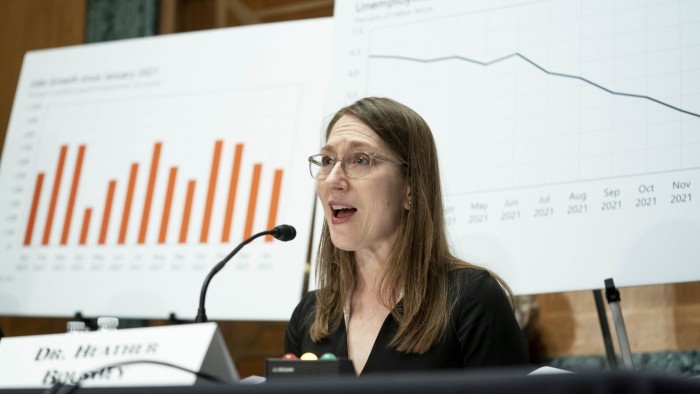White House bullish on rising manufacturing jobs

Roula Khalaf, Editor of the FT, selects her favourite stories in this weekly newsletter.
A senior White House official expects manufacturing employment to keep rising as President Joe Biden’s industrial policies fuel a boom in factory building across America.
The US manufacturing sector reached an important milestone in September of this year: for the first time since late 2008, it employed more than 13mn Americans, according to preliminary monthly data from the US labour department.
But Heather Boushey, a member of the Council of Economic Advisers, predicts additional manufacturing jobs could be created, following evidence that businesses have been sharply increasing construction on new and existing industrial plants this year.
“We have seen this sharp increase in investment in the construction of manufacturing facilities — and that really indicates that we will be seeing hiring down the road or, at least, output increases down the road,’ she tells the Financial Times in an interview. “We don’t know where those firms are in their processes, but we do expect that employment would naturally follow the investment in the facilities.”
During his first two and a half years in office, Biden signed legislation ploughing hundreds of billions of federal dollars into clean energy investments through the Inflation Reduction Act, into subsidies for advanced manufacturing, including semiconductors, through the Chips and Science Act, and into infrastructure upgrades across the country, through the bipartisan infrastructure law.
At the White House, this boom in manufacturing jobs since Biden took office in January 2021 — with 815,000 new positions created overall — is widely seen as vindication of a strategy that has placed industrial America at the heart of economic policy — in a break from recent predecessors, both Republicans and Democrats.
“This is a new way of thinking about how we’re going to power our economy in our society, and that does put manufacturing work at the core of what’s going to provide energy security for our economy, and our national security, in the decades to come,” says Boushey. “This isn’t random. This is very strategic”.
The pace of manufacturing employment gains has slowed this year — with just 37,000 industrial jobs created between December 2022 and September 2023 — as Federal Reserve interest rate increases have led to a slowdown across the economy and the labour market. But the worst fears of a recession have eased as the economy has remained resilient.
Boushey points to specific areas of the industrial labour market that have been especially buoyed.
“We know that the number of folks employed in power generation and supply has been going up. We’ve seen clean energy growth in jobs across
the country. And, in fact, more of the clean energy jobs are going to women,” she says.
“Cleaner jobs are rising faster than traditional fossil-fuel jobs — and more of the Inflation Reduction Act-related investments are in areas with below-average college graduation rates and relatively lower incomes.”
Boushey, who also serves as chief economist of the White House’s “investing in America” cabinet, says that the passage of Biden’s economic plans delivered a sense of certainty for private business and investors about how far government was willing to support manufacturing in the US — a certainty that had long been lacking.
“One of the important things that happened through the passage of all this legislation was that the federal government sent a really strong demand signal,” she says. “Firms were looking to the federal government for some certainty on the direction of policy and [the IRA] really did give firms a lot of sense of exactly where policy was going to go. They didn’t need to wait any more to know what the tax credits were going to be. Most of these tax credits are lasting for a decade.”
Even though some of America’s closest allies and trading partners initially balked at some of Biden’s policies, Boushey says that foreign investment in the sector has been growing. “We have seen an uptick in real new foreign direct investment in US manufacturing between 2021 and 2022,” she says. “It’s split between expanding of businesses that were already in place and new businesses being established.”
White House officials hope that Americans will increasingly feel tangible benefits from Biden’s industrial policies: polls show that most voters disapprove of his handling of the economy.
Inflation has been a huge cloud over Biden’s economic record, even though the rate of price increases has been slowing over the past year.
Boushey argues that there were additional benefits stemming from the Biden administration’s industrial policies. “Manufacturing is important
to innovation in the economy overall,” she says, pointing to “the production of new things that are faster, better new ways of using energy, new ways of producing energy”.
And more manufacturing in the US would help bolster supply chains that have proved to be vulnerable to global shocks. “There’s one thing we all learnt during the pandemic: there’s some things that you just need and you need them when you need them,” Boushey notes. “And you need to make sure that supply chain is resilient.”

Comments